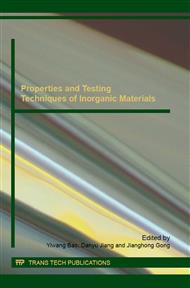[1]
B. Stephan, L. Ludovic, W. Dominique, Modelling of a falling thin film deposited photocatalytic step reactor for water purification: Pesticide treatment, Chem. Eng. J. 169 (2011) 216-225.
DOI: 10.1016/j.cej.2011.03.016
Google Scholar
[2]
S. Flint, T. Markle, S. Thompson, E. Wallace, Bisphenol A exposure, effects, and policy: A wildlife perspective, J. Environ. Manage. 104 (2012) 19-34.
DOI: 10.1016/j.jenvman.2012.03.021
Google Scholar
[3]
C.L. Bianchi, C. Pirola, V. Ragaini, E. Selli, Mechanism and efficiency of atrazine degradation under combined oxidation processes, Appl. Catal. B: Environ. 64 (2006) 131-138.
DOI: 10.1016/j.apcatb.2005.11.009
Google Scholar
[4]
D.P. Mohapatra, S.K. Brar, R.D. Tyagi, R.Y. Surampalli, Physico-chemical pre-treatment and biotransformation of wastewater and wastewater Sludge–Fate of bisphenol A, Chemosphere 78 (2010) 923-941.
DOI: 10.1016/j.chemosphere.2009.12.053
Google Scholar
[5]
M.A. Rauf, M.A. Meetani, S. Hisaindee, An overview on the photocatalytic degradation of azo dyes in the presence of TiO2 doped with selective transition metals, Desalination 276 (2011) 13-27.
DOI: 10.1016/j.desal.2011.03.071
Google Scholar
[6]
K. Nakata, A. Fujishima, TiO2 photocatalysis: Design and applications, J. Photochem. Photobio. C: Photochem. Rev. 13(2012) 169-189.
Google Scholar
[7]
M. d. l.M. Ballari, R. Brandi, O. Alfano, A. Cassano, Mass transfer limitations in photocatalytic reactors employing titanium dioxide suspensions: II. External and internal particle constrains for the reaction, Chem. Eng. J. 136 (2008) 242-255.
DOI: 10.1016/j.cej.2007.03.031
Google Scholar
[8]
C.G. Joseph, G. Li Puma, A. Bono, D. Krishnaiah, Sonophotocatalysis in advanced oxidation process: A short review, Ultrason. Sonochem. 16 (2009) 583-589.
DOI: 10.1016/j.ultsonch.2009.02.002
Google Scholar
[9]
Z. Cheng, X. Quan, Y. Xiong, L. Yang, Y. Huang, Synergistic degradation of methyl orange in an ultrasound intensified photocatalytic reactor, Ultrason. Sonochem. 19 (2012) 1027-1032.
DOI: 10.1016/j.ultsonch.2012.02.008
Google Scholar
[10]
M.T. Taghizadeh, R. Abdollahi, Sonolytic, sonocatalytic and sonophotocatalytic degradation of chitosan in the presence of TiO2 nanoparticles, Ultrason. Sonochem. 18 (2011) 149-157.
DOI: 10.1016/j.ultsonch.2010.04.004
Google Scholar
[11]
W. -S. Chen, S. -C. Huang, Sonophotocatalytic degradation of dinitrotoluenes and trinitrotoluene in industrial wastewater, Chem. Eng. J. 172 (2011) 944-951.
DOI: 10.1016/j.cej.2011.07.006
Google Scholar
[12]
B. Neppolian, L. Ciceri, C.L. Bianchi, F. Grieser, M. Ashokkumar, Sonophotocatalytic degradation of 4-chlorophenol using Bi2O3/TiZrO4 as a visible light responsive photocatalyst, Ultrason. Sonochem. 18 (2011) 135-139.
DOI: 10.1016/j.ultsonch.2010.04.002
Google Scholar
[13]
I.N. Martyanov, E.N. Savinov, K.J. Klabunde, Influence of solution composition and ultrasonic treatment on optical spectra of TiO2 aqueous suspensions, J. Colloid Interf. Sci. 267 (2003) 111-116.
DOI: 10.1016/s0021-9797(03)00678-7
Google Scholar
[14]
S. Kaur, V. Singh, Visible light induced sonophotocatalytic degradation of Reactive Red dye 198 using dye sensitized TiO2, Ultrason. Sonochem. 14 (2007) 531-537.
DOI: 10.1016/j.ultsonch.2006.09.015
Google Scholar
[15]
W. Nam, J. Kim, G. Han, Photocatalytic oxidation of methyl orange in a three-phase fluidized bed reactor, Chemosphere 47 (2002) 1019-1024.
DOI: 10.1016/s0045-6535(01)00327-7
Google Scholar
[16]
J. Madhavan, F. Grieser, M. Ashokkumar, Degradation of orange-G by advanced oxidation processes, Ultrason. Sonochem. 17 (2010) 338-343.
DOI: 10.1016/j.ultsonch.2009.10.008
Google Scholar


